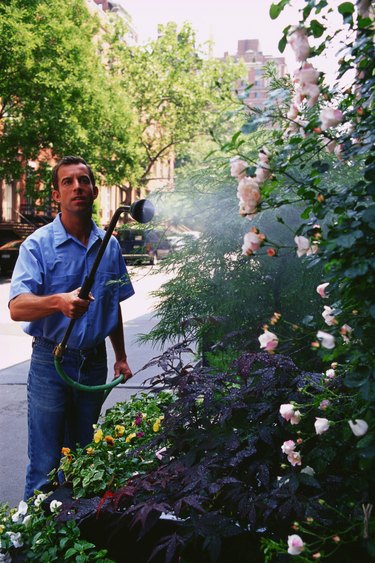
Barberries (Berberis spp.) are spring-flowering shrubs that do quite well in urban settings. Although they put up with a lot, including summertime drought, they have a few sensitivities. If your barberry shrubs look like they're dying during August or other the hot months, then take a close look at whether their cultural requirements match their current conditions.
Identifying Your Barberries
Video of the Day
Probably the most popular barberry in American gardens, Japanese barberry (Berberis thunbergii) is hardy in U.S. Department of Agriculture (USDA) plant hardiness zones 4 through 8. The deciduous shrub grows 3 to 6 feet tall and has a spread of 4 to 7 feet. The closely related wintergreen barberry, also called winterberry barberry (Berberis julianae), is hardy in USDA zones 6 through 9a and grows to a maximum height of 6 feet and a maximum spread of 5 feet. Mentor barberry (Berberis x mentorensis) is also popular; it is hardy in USDA zones 5 through 8.
Video of the Day
Pruning Properly
Pruning barberries can be tough work because they grow so densely, but pruning them is worth the effort. If your barberries begin to look dead in August, it could be because not enough sunlight and air penetrate the middle of the shrubs. That condition causes inner branches to wither and die back, and it can promote diseases. Prune to get rid of thick inner branches and promote shrub interiors that allow light and air to enter, which will improve the health of remaining branches.
Diagnosing Diseases and Pests
Disease is an obvious possibility when trying to figure out why barberries look like they're dying. Although barberries usually are not very susceptible to diseases, they occasionally have problems with fungi such as Anthracnose, which causes brown spots outlined by red on leaves, and powdery mildew, which coats leaf surfaces white. The best way to care for those diseases is to improve the shrubs' access to light and air through pruning. Some pests, including aphids, can be controlled with predatory insects such as ladybugs, while scale insects can be pre-empted with early-spring applications of horticultural oil.
Watering Correctly
Barberries tolerate dry soil well but need at least some water during the hottest months, including August. If you provide water the wrong way, however, you could see adverse effects. Plants do best when they develop deep roots, which occurs when the plants are watered thoroughly but infrequently. If plants are watered often but shallowly, such as the way a sprinkler provides water, then they grow surface roots that aren't good at tapping water reserves deeper in the ground and, therefore, the plants suffer during droughts. If your barberries' leaves are scorched along their edges and falling off, then take a close look at your watering schedule, and revise it if necessary to help the shrubs develop deep roots.